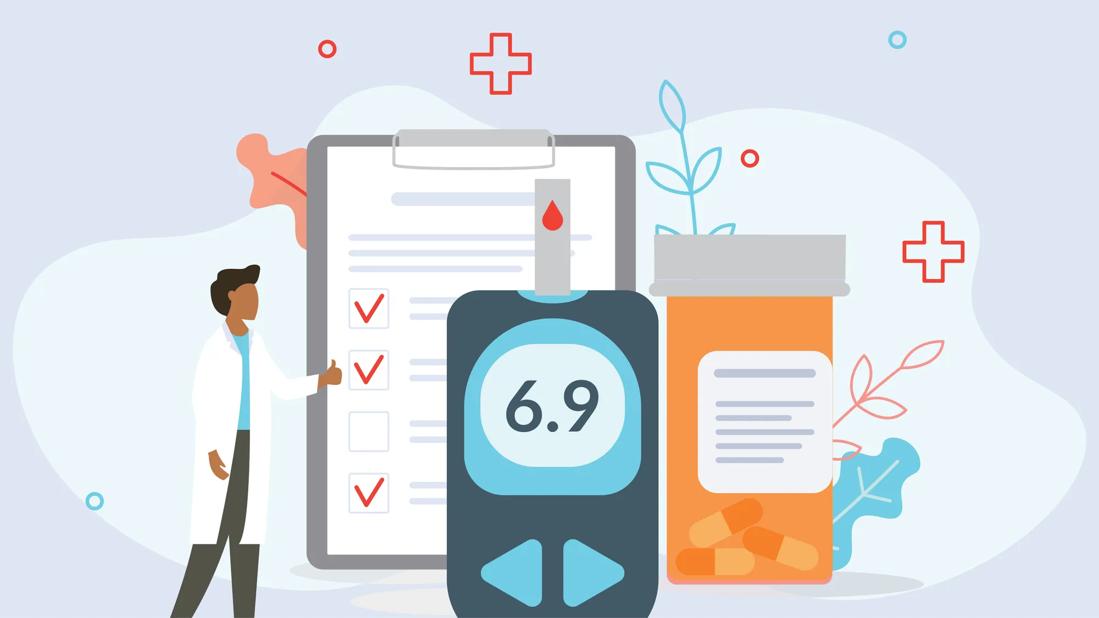Some statins have been shown to slightly increase your risk of diabetes — but that shouldn’t keep you from taking the medication you need

Statins are pretty standard fare for people with high cholesterol. They’re some of the most popular prescription medications in the United States — used by an estimated 92 million people.
Advertisement
Cleveland Clinic is a non-profit academic medical center. Advertising on our site helps support our mission. We do not endorse non-Cleveland Clinic products or services. Policy
So, when you hear reports that some types of statins can put you at higher risk for diabetes, you wonder what that’s all about.
It can be startling to learn that there’s a connection between statins and diabetes. But preventive cardiologist Vikas Sunder, MD, is clear that it’s no reason to stop taking your statins.
“The risk of living with untreated high cholesterol is far worse than the risk of potentially developing diabetes as a result of taking the statin,” he states.
Dr. Sunder tells us about the connection between cholesterol-reducing medications and diabetes and shares advice about what you should do about it.
Studies have shown that taking certain statins may increase your risk for diabetes.
The good news? The risk of developing diabetes related to statins isn’t the same across the board. Dr. Sunder says that people with a higher risk of developing diabetes after starting statins have two things in common:
Some scientists believe high-intensity statins can get in the way of the body using insulin properly. That can lead to high blood sugar and, over time, diabetes. But further studies are needed to understand why the connection exists.
Advertisement
Even still, the association between statins and diabetes is strong enough that in 2012, the U.S. Food and Drug Association (FDA) approved changes in the labeling of high-intensity statins to include a warning about the risk of raised blood sugar.
“We know that high-intensity statins tend to increase the risk of diabetes,” Dr. Sunder notes. “And I think it’s important for healthcare providers to discuss that upfront with people when they’re prescribed a statin, especially for people who may be at higher risk.”
Let’s take a closer look at the connection.
Statins come in different formulations and go by a variety of brand names. They’re all used to treat high cholesterol, but they work in slightly different ways and come in different dosages.
The statins that have been shown to be more likely to raise your risk for diabetes are the so-called “high-intensity” ones. Namely:
Lower dosages of these medications and other statin formulations haven’t been shown to carry as much risk for developing diabetes.
“Typically, high-intensity statins are given when people have very elevated LDL cholesterol and people who have a buildup of plaques in their arteries (atherosclerosis),” Dr. Sunder shares. “That can put you at very great risk for serious and life-threatening heart disease. A higher-intensity statin can help to lower that risk.”
In other words, the higher your risk for serious complications from high cholesterol, the more likely you are to be treated with a high-intensity statin.
It’s not only the statin that can raise your risk for diabetes. Your risk factors for diabetes before you begin statins can make a difference as well.
“What we’ve seen is that in people who already showed some signs of being at risk for diabetes, high-intensity statins can accelerate the progression,” Dr. Sunder says.
Researchers have found that people who take high-intensity statins may be at greater risk for diabetes if they also have diabetes risk factors like:
While the warnings can come as a shock, it’s important to remember this: The risk of not taking a statin is much greater than the risk of developing diabetes from taking statins.
Statins are used to lower cholesterol. And maintaining a healthy cholesterol level is important. Because untreated high cholesterol can lead to dangerous and life-threatening heart events, including:
Advertisement
Study after study has confirmed that taking statins reduces your risk of these serious heart events. And while they may raise your risk for diabetes, the benefits are much more significant than the risks.
“It’s clear that statins save lives,” Dr. Sunder echoes. “If you’re prescribed a statin, it’s important to continue the treatment and discuss any side effects or risks with your healthcare provider.”
And while you’re taking statins, you can help lower your risk for diabetes and other conditions by maintaining a healthy lifestyle.
Maintain (or get to) a healthy weight. Eat a heart-healthy diet that emphasizes lean protein, healthy fats and plenty of plant-based foods. Exercise at least 150 minutes per week. And get enough sleep.
If you’re concerned about how statins affect your well-being, talk with your healthcare provider. They can help ensure that your risk is properly in balance with the rewards of these lifesaving meds.
Advertisement
Learn more about our editorial process.
Advertisement

Medications known as statins can lower cholesterol levels to minimize the risk of blocked arteries

Fatty fish, flaxseed, extra virgin olive oil and nuts may help raise your HDL number

Grapefruit contains natural chemical compounds that can interfere with certain medications when it’s consumed in large amounts

Up to 30% of people who take the cholesterol-lowering medication feel aches and soreness

There’s not enough evidence to show that this supplement has any effect on muscle aches from cholesterol-lowering meds

There’s no limit on the amount you should have each day, but experts are focused on saturated fat

Statin use has been associated with weight gain but the reasons aren’t clear — and the benefits of statins far outweigh the risks

Lifestyle adjustments can help you raise your HDL, the ‘good’ cholesterol

Babies can get congested easily, but you can calm their cough by keeping them hydrated, using nasal drops and running a humidifier

Weight loss may cause loose, sagging skin and muscle loss to your rear

Several conditions, like vitiligo and fungal infection, can cause a loss of pigmentation, leading to white spots or patches on your skin